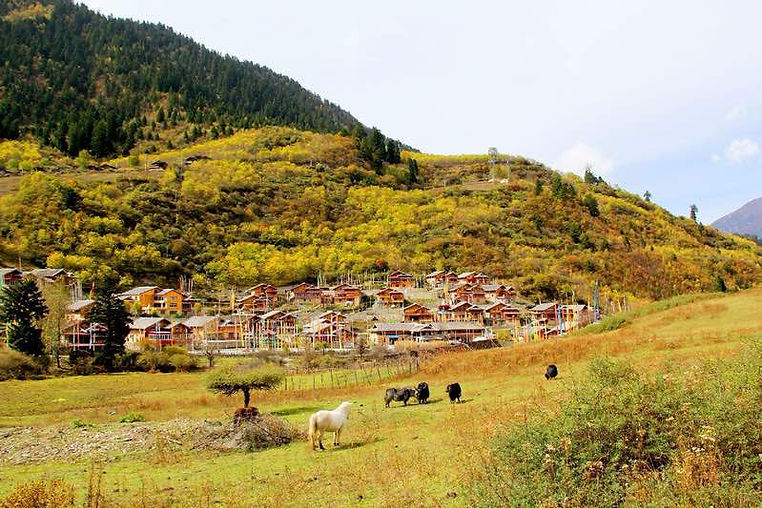Jiuzhaigou — Colorful Fairyland with Picturesque Waterscapes
Jiuzhaigou, Jiuzhaigou Valley Scenic, and Historic Interest Areas
Jiuzhaigou County, initially named Nanping and Yangtong, became part of the territory of the Han Dynasty over 2000 years ago.
In 1998, it was renamed Jiuzhaigou, taking its name from the stunning Jiuzhaigou Valley Scenic and Historic Interest Area located inside.
The Jiuzhaigou Valley Scenic and Historic Interest Area, a UNESCO World Heritage Site, is renowned for its stunning, colorful waterscapes, diverse ecosystems, picturesque terraces, and impressive karst views.

Beautiful Lake and Forests in the Jiuzhaigou Valley Scenic and Historic Interest Area of Sichuan Province, Photo by Leonoyes.

Jianzhuhai or Arrow Bamboo Lake Waterfall, Photo by Zhang Kunkun.
Jiuzhaigou Facts and Important Data
-
Jiuzhaigou was named after nine Tibetan stockaded villages that have been inhabiting this area for centuries.
-
Besides Tibetan, there are other minority ethnic groups living in Jiuzhaigou County, such as Qiang and Hui.
-
Its altitude varies from about 1900 to over 4500 meters.
-
It has rich biological resources, with 2822 vegetation and about 42 endangered animal species, including the giant panda and golden monkey.
-
The Jiuzhaigou Valley Scenic and Historic Interest Area is over 50 kilometers long, 720 square kilometers large, and has over 108 beautiful lakes scattered.

Jiuzhai Plank Road (Jiuzhai Zhandao) Along the Xiongmaohai or Panda Lake, Photo by Li Heng.
Origin Legend of Jiuzhaigou
A long time ago, two immortals fell in love with each other.
However, their love token, a glorious mirror, accidentally dropped on earth.
The mirror got broken and incarnated into 108 stunning lakes, and its decorative gems became trees and flowers in the surroundings.
Together, they formed the picturesque Jiuzhaigou.

Stunning Lake and Plants in the Jiuzhaigou Valley Scenic and Historic Interest Area, Photo by Leonoyes.
Valuable Cultural Attractions of Jiuzhaigou
Tibetan Culture
Jiuzhaigou was named after nine Tibetan stockaded villages, whose culture is one of the most important attractions of this area.
From architectural styles, religion, clothes, and food, to local festivals and activities, inhabitants hold apparent Tibetan style and blend traces with other ethnic groups in this area.

Shuzhengzhai, One of the Nine Tibetan Stockaded Villages.
Qiang Culture and the Taoping Qiang Stockaded Village
Qiang or Chiang, a minority group in China with a rich culture and history, is famous for its stone building complex.
The Taoping Qiang Stockaded Village, or Taoping Qiangzhai, was first built in the year 111 BC, and some Qiang people have been living in this area for centuries.
Today, some still live in villages following their traditions, which well preserved Qiang culture, including music, dance, architecture, food, clothes, handicraft skills, etc.

Ancient Stone Building Complex of the Taoping Qiang Stockaded Village.
Impressive Natural Scenic Views of Jiuzhaigou

Beautiful Lakes and Plants of Shuzheng Valley or Shuzhenghai, Photo by Zeng Yongqian.

Magnificent Nuorilang Waterfall, Photo by Arong Shijiao.

Snowy View in Winter, Photo from Official Site.

Colorful Forests of Xiniuhai or Rhinoceros Lake, Photo by Zeng Yongqian.

Ice Waterfall View in Winter, Photo from Official Site.
You Might Also Like:
Ancient Minority Town Under Stunning Snow Mountain — Lijiang
The Huizhou Culture in Ink Paintings — Huizhou in Anhui
Exceptional Museum on Gobi Desert — Dunhuang on Silk Road
The Best Representative of a Traditional Chinese Han City — Pingyao
Chinese Palaces — Architecture and Art of Imperial Feats
Chinese Gardens — Aesthetics, Philosophy, and Architecture in Nature
Chinese Architecture — Tradition, Characteristic and Style
Ancient Towns with Exceptional Values
Magnificent Landmarks and Their Epic Stories
Cultural Meanings of Extraordinary Attractions in China
Legend, History, and Culture of Chinese Lakes
